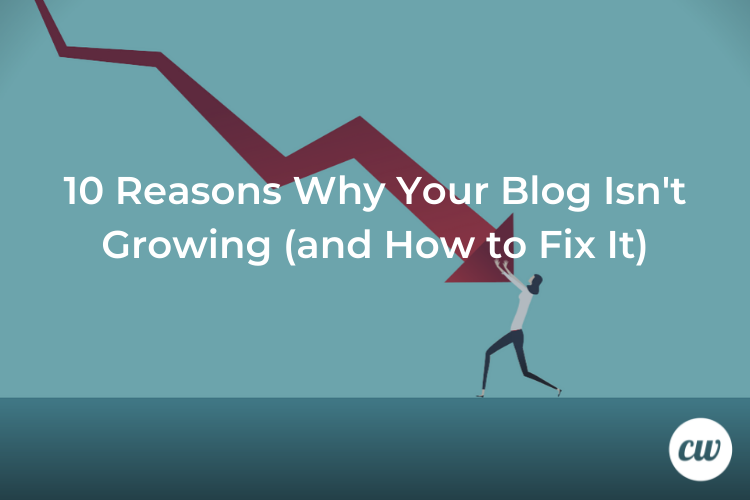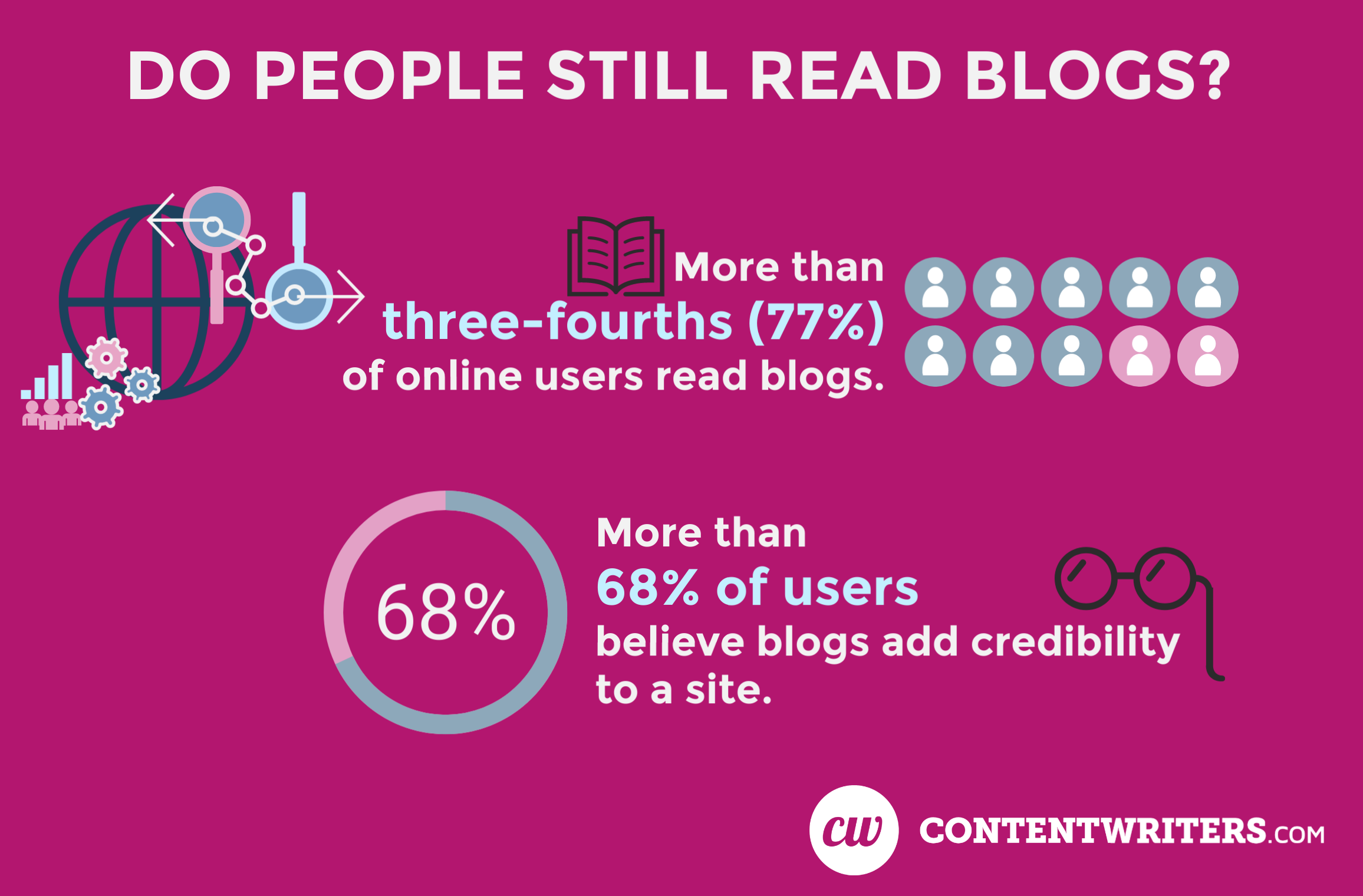
10 Reasons Why Your Blog Isn’t Growing (and How to Fix It)
It takes time and commitment to produce blog content regularly. But if your dream blog isn’t growing in such a dreamy way, you may be understandably frustrated. You may also be scratching your head and wondering why you’re not growing your audience, making money, or getting raves from blog visitors.
If Google Analytics is constantly reminding you how few page views your blog is getting every time you check key blogging-related stats, take comfort in knowing there are ways you can remedy this situation. This advice also applies if you have an existing blog that’s stalling growth-wise.
Below, you’ll find a list of 10 reasons why your blog may not be growing. Additionally, you’ll discover some suggestions for what to do to fix each of the issues mentioned.
1. You’re Not Truly Passionate about the Focus of Your Blog
If you’re not fully devoted to the topic of focus of your blog, how can you expect anyone else to be? Even if you’ve only shifted from your preferred topic to one that’s related but more popular, expect a lack of passion (or interest) to be evident to readers.
The Fix
Having the right mindset is what ultimately makes blog content work. Keeping this in mind, here’s what you can do to fix this issue: choose a topic you’re devoted to.
Granted, what you prefer to post about may not be THE most popular topic for your industry or niche. However, you’ll see some degree of steady growth if readers can tell you’re personally invested and fully interested in what you’re blogging about.

2. You don’t have an email list
You may be experiencing insufficient blog growth if you don’t yet have an email list. Blogging is only going to be effective if you are actively building relationships with your readers. An email list is one of the most effective ways to accomplish this goal.
The Fix
A simple way to get started with an email list is to ask blog readers to subscribe. These subscriptions will give you the basic information necessary to start an email list.
Subscribers will get notifications when you post something new. You can also segment your list based on what posts subscribers are commenting on and sharing to further target individual interests and encourage engagement with your blog.
3. Inconsistent Quality with Blog Content
Even the best bloggers have moments where they may be crunched for time and tempted to crank out a fairly mundane post or nothing more than a re-do of a previous post. Unfortunately, it’s not enough to quickly ramble through a 200-300 word post and call it a day, even if you have a valid reason for doing so.
The Fix
Before you post something new, reduce the risk of disappointing your readers with a lack of sufficient quality by asking yourself the following questions:
- Is this post on par with the other ones in terms of how it’s written and presented?
- Have I delivered on the implied promise suggested by my blog’s purpose or premise?
- Would I find this post interesting and engaging if I came across it?
On a related note, the optimal content length for blog posts in 2021 is, according to data compiled by HubSpot, between 2,100 and 2,400 words. Even so, the total length of your posts doesn’t matter as much as the quality.
Shorter posts can still work well for times when you’re a bit pressed for time as long as the quality is still kept in mind. Plus, there’s no point in stretching out a really good 500-word post into a mediocre 1000-word one just for the sake of upping your word count.
4. No Clear Sense of Order or Organization
Your blog may not be growing if it reminds visitors of their messy childhood bedroom. If it’s difficult to find new posts or check out old ones without digging through a bunch of clutter, readers may quickly bail on your blog.
Clicktale reports blogs have an average bounce rate of 70 to 90 percent – although bounce rates don’t significantly impact a blog’s ranking for SEO purposes. However, it’s still a metric to keep an eye on to determine how visitors are interacting with your blog’s content. If you’re noticing an excessively high bounce rate and your blog has no clear organization, this may be why it’s not growing.
The Fix
Create a sense of order and organization for your blog by:
- Putting your posts into broad categories
- Creating sub-categories within each of your main categories
- Using tags to direct visitors to related blog content
- Putting your newer content front-and-center
- Archiving your older posts in a way that allows this content to be easily accessed
- Using internal links to take readers to related archived posts
- Periodically sorting through your posts to remove ones no longer relevant or ones you’ve already re-written or updated
5. Lack of Variety with Your Posts
Variety is more than just the spice of life, it’s also what makes a blog inviting for visitors. If you’re sticking with a similar style for all your posts, this may be why your blog’s growth has been stunted.
The Fix
There are many different options for how blog content can be presented. Mix things up style-wise with your blog by considering any of the following possibilities with blog-related content:
- Lists
- Tutorials/how-to’s
- Resource or link list posts based on curated content
- Checklists
- Personal stories or in-depth posts
- Reviews
- Interviews
Give your blog posts even more variety in a way that encourages growth by mixing up text with relevant images and, when appropriate, a complimentary video. Infographics can also add some flavor to your blog posts by presenting your main points in a visually appealing and easily digestible way.
6. Being Too Active on Other Platforms
If your blog is just one of many things on a very busy digital to-do list, this may be the reason for lackluster results with your blogging efforts. Working too hard to maintain a digital presence could leave you taking shortcuts, like recycling content from other sources for your blog posts.
Being too busy with various platforms may also have you posting inconsistently and doing other things that could impact your blog’s performance.
The Fix
Narrow down your digital to-do list focusing on a handful of platforms you can manage. Another option is to delegate some of your blogging obligations.
If the problem is trying to juggle multiple blogs, consider folding your under-performing blogs or consolidating content into one blog that’s easier to manage.
7. No Definition for Your Brand’s Style or Identity
Blogging is often more effective when there’s a clear identity behind it. In other words, someone coming to your blog should be able to easily tell they’ve come across your blog content.
The reason why this tends to work well is because of the natural inclination of blog visitors to stick with what’s familiar. If your blog has no defined style or identity, readers may be hesitant to commit or keep coming back. You’ll also be building trust by presenting your blog in a way that makes it easy to identify and clearly linked to your brand’s core values.
The Fix
There are many ways to define your blog’s identity and style for your intended audience. With blog content, set up guidelines for anyone posting or guest posting. Doing so keeps the tone and general appearance of your blog and its content consistent.
With the appearance of your blog, define your brand’s style and identify by:
- Using 3-4 go-to colors
- Limiting fonts and font sizes to maintain consistency
- Creating a logo or stylized title that makes your blog more identifiable

8. No Clear Goals for Your Blog
What’s your ultimate vision for your blog? What kind of growth do you expect for your blog? If you haven’t yet given much thought to these types of questions this may be why your blog isn’t growing.
The goals you have for blogging will determine how everything else works with your blog, from how you engage with visitors and readers to how much time and effort you put into it. A blog that’s only a side hobby, for instance, is going to very different than the one you intend to use as your primary source of income – or an extension of your business.
The Fix
First off, stay focused on why you started your blog in the first place. You’re not going to inspire engagement and earn loyalty from readers if your blog drifts off course or appears to have no clear rhyme or reason.
Next, make it easier to set reasonable goals for your blog by:
- Defining the overall goal of your blog
- Setting short-term goals you feel reasonably confident you can achieve
- Having longer-term goals that will serve as a guide for where your blog will eventually go with its content
9. Not Marketing Your Blog
So, you’ve put a lot of time and effort into blogging and, let’s say, you’ve covered all the blogging bases already covered here. Way to go! But, wait, why are you still getting very little payoff for all your hard work and diligence?!?
If this applies to your situation, the problem may be a failure to market your blog. After all, it’s estimated there are 600 million blogs in the world today. So, not surprisingly, it’s easy to get lost in a sea of blog content if you’re not making an effort to reach out to your target audience.
The Fix
Your blog isn’t going to grow if you expect your awesome content to be discovered. The fix here is to put together a marketing plan for your blog and its content.
The good thing about marketing a blog is the many possibilities with this process. A perfect place to start is with your social media pages and any existing email lists you may have.
Blog-related marketing efforts can also involve:
- Complementing each post with visuals
- Using on-page and off-page SEO strategies to make your blog searchable
- Writing compelling, brief, and descriptive titles for your posts
- Repurposing your blog-based content on your website and social pages to direct visitors back to your more in-depth blog content
- Making the effort to encourage quality and relevant links that point back to your blog from trusted sources
- Creating a UTM link to attract marketing campaigns
- Answering questions on Quora
- Using heat maps
Marketing your blog can also involve reaching out to online influencers in your niche. Additionally, it can be beneficial to become a guest blogger yourself on popular blogs specific to your niche.
One other possibility with blog-related marketing is to place your blog directly on your website or to make it accessible from your site. People tend to like convenience, so if your blog is easy to find and get to, you may be rewarded with steady growth.
10. Blog Content Isn’t a Good Fit for Your Target Audience
Be willing to take an honest look at your blog content if you’re not seeing the desired or expected results with your topics. Even if you firmly believe you’re producing amazing content, there may be some issues you’re not aware of yet.
One possibility is that your content is not in line with what your intended audience expects based on factors such as:
- Your blog’s title
- The nature of the content
- The way your blog’s topic is covered
The Fix
If a disconnect with your target audience is an issue, fine-tune your blog content so it’s better tailored to your audience. A/B testing your posts is one way to do this. What you’ll be doing with A/B testing is comparing two similar posts and seeing which one gets the best results
Another potential fix is to adjust your blog so it targets an audience likely to be more appreciative of how you’re approaching the topic. Yes, this will likely mean redefining your demographics and other audience data points, but it could be that is what is necessary to give you the growth you want to see.
Final Thoughts
Many issues can affect your blog or make blogging seem more like a chore than something you truly enjoy. Once you narrow down the issues likely stalling growth, however, you can take steps to get the results you want.
If, for instance, a lack of fresh, consistent content is the main issue, welcoming guest blog posts is one way to resolve this problem. Once you make some adjustments, whatever they end up being, have patience. It will take some time to see a shift in engagement patterns.
Lastly, stay on top of your blogging stats. This way you can make appropriate adjustments to your content and how it’s presented once you get a better feel for how your blog content is performing.
Ken is a freelance writer currently living in the Pittsburgh area of Pennsylvania. Born in California, his fondness for writing dates back to elementary school writing contests and led to positions on both high school and college newspapers. He earned a degree in Journalism and Communications from Point Park University and did work in data entry after college before transitioning to a full-time career as a freelance writer. While his areas of expertise are marketing and health-related content, Ken is a versatile writer and enjoys exploring and researching a variety of topics. When not busy knocking out articles, he likes to spend time with friends, go for walks, and discover new and exciting things about the world around him.




